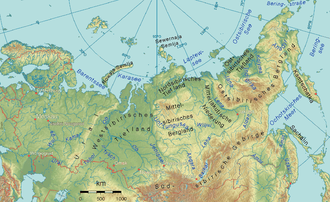Western Siberia
As Western Siberia in politics and geography of the western part of Siberia understood that from the Urals to the east to the Central Siberian mountains ranges. With an area of around 2,500,000 km², the West Siberian lowland , which is shaped by the great rivers Ob and Yenisei , takes up the majority , while the plateau of Kazakhstan begins in the south and part of the South Siberian Mountains (Russian Altai and Sayan Mountains ) rise up in the southeast .
Western Siberia makes up almost exactly a third of all of Siberia (approx. 11 million square kilometers) and is clearly delimited geographically by the peripheral mountains. As such, however, it is not one of the major landscapes of Russia , but the geomorphologically more uniform regions of the West Siberian Plain and the South Siberian Mountains .
The largest city in Western Siberia is Novosibirsk on the middle reaches of the Ob, followed by Omsk ; the equally large cities of Yekaterinburg (Sverdlovsk), Chelyabinsk and Magnitogorsk, however, are assigned to the Ural region.
Other large cities are (from west to east): Kurgan , Tyumen , Barnaul , Tomsk , Kemerovo , Novokuznetsk , and (on the border of Central Siberia) Krasnoyarsk . Without exception, they are located in the southern quarter of the region ( geographical latitude below 57 °), because north of it the permafrost soil makes it difficult to settle more densely.
Western Siberia, which was already of particular importance to the Russian Empire due to its mineral resources , was developed, especially through the Trans-Siberian Railway and river navigation on the main rivers Tobol , Irtysh , Ob and Yenisei .
In Europe, the region was first made known at the beginning of the 21st century by the oil spill in Western Siberia , which was discovered in particular by Greenpeace . It is one of the largest oil-contaminated land areas on earth.
